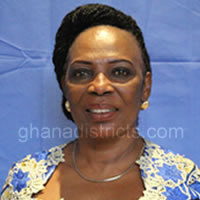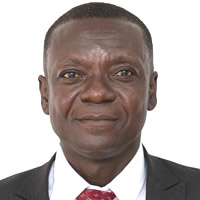Location and Size
AMA has a total land size of 200 sq. km and is made up of six sub metros namely Okaikoi, Ashiedu Keteke, Ayawaso, Kpeshie, Osu Klotey and Ablekuma. The Southern boundary of the Metropolis of Accra is the Gulf of Guinea from Gbegbegese to the Mukwe Lagoon near Regional Maritime Academy. The boundary continues along the Maritime Road to join the Accra-Tema road to Nungua Police Station Barrie
It turns right to the Ashaiman Municipal road till the Railway overhead Bridge on the Motorway and continues to Mile Post 91/2. From here the boundary continues to the road between the Institute of Professional Studies ( IPS) and the Accra Teachers Training College (ATRACO), westwards crossing the Accra-Aburi Road to the University of Ghana behind the great Hall to Kisiseman and Christian Village to join the Accra Nsawam Road at the Achimota Brewery Road Junction.
It turns left for 500m to the Aayeayeefee Street junction and through the Aayeayeefee Street to the Bridge over the Achimota Stream, then turns right along the stream to the high tension lines to the Achwilage Street and through Achwilage Street to the range of the Awoshie Hills and turns left again along the hills to the boundary between Kokorko (Ga District) and Awoshie (Accra Metropolis), from here it turns left along the swampy area and crossing the motorway through the swampy area to the bridge on the Sakumono Stream on the Accra-Winneba road and streatching along the stream till the starting point at Gbegbeyese.
Notwithstanding these boundaries, there are however some conflict points with adjoining district Assemblies, namely the Ga District Authority (GDA) and the Tema Municipal Authority (TMA).It must be emphasised that the presence of the conflict points has led to shrinking size of AMA boundaries (de-facto) and loss of revenue.There is also conflict between the Assemblies concerned, which will impede collaborative efforts for development. Table 1 below shows the conflict points along the boundaries of AMA.
Topology & Drainage
Drainage
The Accra Metropolitan drainage catchment area extends from the eastern boundary of the Nyanyanu catchment on the west of greater Accra regional boundary to Laloi east of Tema.
Densu River Catchment and Sakumo Lagoon
This is the largest of all the four coastal basins within the study area. The total drainage area is about 2500 sq. km. It is divided into two sections above and below the Weija dam.The northern section of the basin, which extends inland along the Densu River and its tributaries 100 km, is hilly with the highest point reaching 230m above mean sea level.
The southern section of the basin is low lying land comprising the Sakumo I lagoon and Panbros salt pans. The Lafa steam flows into the lagoon and drains much of the western area of Accra including Dansoman, Kwashieman, McCarthy Hill and Awoshie. Much of this catchment is now urbanised.Flooding is common along the 8km of the Densu River below the Weija dam whenever there is overtopping or deliberate release of water over the spillway.
Flooding is also prevalent in Dansoman area and along the Lafa stream where it crosses the Winneba and motorway extension roads. Few of the drainage channels in the catchment are constructed.As a result, there is heavy erosion of drainage channels - many of which flow down existing tracks and roads. Access to this area is often cut off and roads become impassable during heavy rains.
Korle-Chemu Catchment
This catchment covers an area of 250 km2. It is bounded on the west by a line running roughly south-north from Gbegbeyise, Dansoman, Kwashieman, New Achimota; on the north by the Achimota -Lagon axis; and to the east by East Legon, the Airport and Ridge. The highest spot on the basin in about 308m above sea level.
The principal streams that drain the catchment are the Odaw River and its tributaries, the Nima, Onyasia, Dakobi and Ado. The principal outlet for water in this catchment is the Korle Lagoon. There is a minor outlet at Chemu Lagoon.The Korle - Chemu catchment contains the major urbanised areas of Accra. Many of the drainage channels are poorly developed and maintained.
Erosion and siltation of drains is a serious problem. In low-lying areas flooding is a serious problem, with many houses being inundated by floodwater during and after heavy rains.Following the Netherlands Engineering consultants (NEDECO) report in 1963, a considerable amount of work was done, particularly in connection with the Korle Lagoon and the Odaw River, but work was eventually stopped. The drainage channels, until recently, had not been maintained resulting in the silting of the major watercourses and the lagoon.
In low lying areas near the Accra Academy in Kaneshie, rapid run off from Asoredanho overflows into the Bank of Ghana flats because inlet to the Kaneshie drains is inadequately designed. Similar problems occur in the industrial land and cemetery area around the Obetsebi Lamptey Circle where the interceptor drain and gullies are inadequate.There are many other areas, like Nima, Dzorwulu, Darkuman and Alajo which have localised flooding problems caused by inadequate drainage channels and the flat nature of the terrain.
Most roads in the catchment are not surfaced and side drains are mainly uncovered. The channels become convenient places for the dumping of refuse. This, combined with erosion, results in choked and silted drain age channels.These problems must be tackled by regular maintenance and the construction of new channels and culverts where existing ones are shown to be inadequate. Until good access roads with properly constructed side drains are provided in all urban areas, old and developing, drainage and flooding will continue to be a problem every rainy season.
Kpeshie Catchment
The Kpeshie drainage basin covers a relatively small catchment area of 110 km2. It is bounded on the east by the Military Academy at Teshie, on the north by a line south of Madina and Ajirignano.It covers the eastern part of Accra, Ridge, Cantonments, Osu, Labadi and Burma camp areas. Streams in the catchment generally flow north to south, emptying directly into the principal outlet to the sea at Kpeshie Lagoon or the small Korle Lagoon at Osu.
Improvements have been made to straighten some of the watercourses in Christianborg and South La. Drainage in the La Township is inadequate and many waterlogged areas become flooded with light rains. In heavy rains, fence walls collapse and foundations are undermined.Southern Teshie is subject to severe flooding in the rainy season. Large parts of Teshie are without proper drainage with only the lower channel sections leading to the sea outfall. Most channels are heavily silted and choked with refuse in the middle reaches.
Songo-Mokwe Catchment
This is the smallest drainage basin in the metropolitan area. It covers about 50km2, draining the area of Teshie to the ridgeline with the Sakumo II catchment. Two main streams drain the area flowing into the Mokwe and Songo Lagoons. Much of this catchment is undergoing residential development.Drainage channels in the western part of the catchment are not adequate resulting in serious flooding in the Teshie/Nungua estates and the cutting of the main coastal road to Tema.
The storm-water channels constructed alongside and under this road are completely inadequate. In central Nungua, the market cannot operate regularly because of waterlogged ground and poor drainage.The valley before the police barrier at Nungua also has inadequately sized culverts. Poor maintenance of the earth drains along the area of the Maritime Academy also causes flooding of the coastal road.
Climate & Vegetation
Climate
The Accra Metropolitan Assembly lies in the Savannah zone. There are two rainy seasons. The average annual rainfall is about 730mm, which falls primarily during the two rainy seasons.
The first begins in May and ends in mid-July. The second season begins in mid-August and ends in October. Rain usually falls in intensive short storms and give rise to local flooding where drainage channels are obstructed.There is very little variation in temperature throughout the year. The mean monthly temperature ranges from 24.7°c in August (the coolest) to 28°c in March (the hottest) with annual average of 26.8°c.
As the area is close to the equator, the daylight hours are practically uniform during the year. Relative humidity is generally high varying from 65% in the mid-afternoon to 95% at night. The predominant wind direction in Accra is from the WSW to NNE sectors. Wind speeds normally range between 8 to 16 km/hr. High wind gusts occur with thunderstorm activity, which pass in squall along the coast.
The maximum wind speed record in Accra is 107.4 km/hr (58 knots). Strong winds associated with thunderstorm activity often cause damage to property by removing roofing material. Several areas of Accra experience micro climatic effects. Low profile drainage basins with a north-south orientation are not as well ventilated as that orientated east west.
Air is often trapped in pockets and an insulation effect gives rise to local increase in air temperature of several degrees. This occurs in the Accra Newtown, sports complex areas.
Vegetation
There is evidence to suggest the vegetation of the metropolitan areas has been altered in the more recent past century by climatic and other factors. Much of the metropolitan area was believed to have been covered by dense forest of which only a few remnant trees survive.
A climatic change combined with the gradient of the plains and cultivation has imposed vegetational structures similar to those of the southern shale, Sudan and Guinea Savannahs all of which lie north of the Accra plains.There are three broad vegetation zones in the metropolitan area, which comprise shrub land, grassland and coastal lands. Only the shrub land occurs more commonly in the western outskirts and in the north towards the Aburi hills.
It consists of dense clusters of small trees and shrubs, which grow, to an average height of five metres. The grasses are a mixture of species found in the undergrowth of forests.They are short, and rarely grow beyond one metre. Ground herbs are found on the edge of the shrub. They include species, which normally flourish after fire.
The coastal zone comprises two vegetation types, wetland and dunes. The coastal wetland zone is highly productive and an important habitat for marine and terrestrial-mainly bird life.Mangroves, comprising two dominant species, are found in the tidal zone of all estuaries sand lagoons. Salt tolerant grass species cover substantial low-lying areas surrounding the lagoons.
These grasslands have an important primary production role in providing nutrients for prawns and juvenile fish in the lagoon systems. In recent times, wetlands are however being encroached upon. Protection of the coastal wetland zone is very important to the long-term sustainability of the fish industry, which the Ga population of Accra depend upon.
The dune lands have been formed by a combination of wave action and wind. They are most unstable but stretch back several hundred metres in places. There are several shrub and grassland species, which grow and play an important role in stabilising dunes.
Coconuts and palms grow well in this zone, providing protection and an economic crop. Most of the coconuts were panted in the 1920s but it is estimated that over 80% of those plantations have disappeared as a result of felling, disease and coastal erosion. The loss of these trees is one of the principal reasons for the severity of erosion in some areas.
In addition to the natural vegetation zones, a number of introduced trees and shrubs thrive in the metropolitan area. Neems, mangoes, cassias, avocados, and palms are prominent trees on the Accra landscape. Introduced shrubs like bouganvilia are also very prominent. these are being damaged from residential encroachment, bush fire, sand collection and illegal tree felling.
Most of the open spaces in Accra are used for the cultivation of food crops like corn, okro, tomatoes and other vegetables. Fertilizers and insecticides are used in these areas. Constant felling of trees, bad farming practices and annual burning has altered the vegetation from “dry forest” and greatly depleted the fertility of the soil.
Aquatic Vegetation
Apart from mangroves and salt marsh grasses, which grow in the intertidal zone, sea grasses or attached algae also occur mainly in rocky areas and wave cut platforms.These areas have increased as a result of erosion exposing the underlying bedrock - especially to the east of Tema. They have an important role in the coastal ecosystem because of their high rate of primary production in the provision of food and shelter for the survival of shrimps, prawns and many species of fin fishes.
Ocean floor sea gases are confined to a few sheltered areas of the coastline and the lagoons. The ocean floor regime is too unstable to support large areas of sea grass.
Terrestrial Fauna
Different species of antelopes, squirrels, monkeys and reptiles live in Accra. Many animals such as the Togob have grass cutter, bush baby and bossman potto are found in the Achimota forest and outside the urbanised area. Most animals have been pushed inland because for the rapid expansion of settlements in the Metropolitan area. Many species of snakes (some venomous) and lizards are found throughout the Metropolitan area.
Apart from the above-mentioned fauna a great number of domestic animals - donkey, sheep, and goat, chicken are kept domestically in the metropolitan area.
To the north east of Accra on the Akosombo Road lie the Shai Hills. This is a small game park with several of these isolated hills. Several species of monkeys, ground foraging animals and birds inhabit this area.The Akuapim Hills also provide sheltered habitats for many bird and animal species. The two areas are sparsely populated and generally unsuitable for agriculture use.
The long-term prospects of species protection in the Akuapim and Shail Hills are good. Over 120 indigenous, migratory and exotic bird species have been counted in the Metropolitan area. Wetland species occur mainly in the Densu delta and Sakumo I and II lagoons.
Sakumo II lagoon hosts 10 species of birds of national and international importance. These lagoons could easily be endangered by pollution and is already experiencing adverse impacts from urban development.
Metropolitan bird life is diverse and in spacious residential areas prolific. The many exotic trees planted in the inner city areas provide a suitable habitat for food and shelter, and the lack of predator species has enabled numbers to grow.
Aquatic Fauna
The open lagoon systems support a wide range of crustacean, mollusks, gastropods, predatory and bottom feeding fish. The lagoons are important breeding grounds giving adequate protection against large predator species and a continual supply of nutrients and organisms for food.
The habitat of many of the lagoons is or has been modified by development and increasing levels of pollution. Some species in the lagoons - in particular the Korle lagoon - are no longer suitable for human consumption.Protection of the water quality and vegetation in the lagoons is important to the long-term sustainability of aquatic fauna along the coastline.
The ocean supports a wide range of pelagic and bottom feeding fish. Common species are grouper, mackerel, cassava fish, African lookdown, sole shark and tiger fish.Stocks of off shore species have not been depleted mainly because fishing techniques result in a significant loss of smaller fish from nets.
Evidence suggests that on-shore species are nearing exhaustion caused by excessive catches of juvenile and small fish. The loss of this resource will have a substantial impact on the indigenous population of Accra whose livelihood is dependent on fishing.
Weija reservoir, the marshes at the mouth of the Densu River, the Sakumo lagoon near the Panbros salt industry constitute the most important fresh water wetlands for aquatic fauna.Apart from harbouring a variety of mportant commercial fish species like tilapia and atfish, they also act as breeding grounds for animals, which are adapted to the characteristic coastal Savannah vegetation.
Geology & Soil
Geology
The geology of the AMA consists of Precambrian Dahomeyan schists, granodiorites, granites gneiss and amphibolites to late Precambrian Togo series comprising mainly quartzite, phillites, phylitones and quartz breccias. Other formations found are the palaeozoic accraian sediments - sandstone, shales and interbedded sandstone-shale with gypsum lenses.
The coastline of Accra comprises a series of resistant rock outcrops and platforms and sandy beaches near the mouth of the lagoons.The coastline is exposed and because of the close and the Korle (Central Accra).
Soils
The soils in the metropolitan area can be divided into four main groups: drift materials resulting from deposits by wind blown erosion; alluvial and marine motted clays of comparatively recent origin derived from underlying shales; residual clays and gravels derived from weathered quartzites, gneiss and schist rocks, and lateritic sandy clay soils derived from weathered Accraian sandstone bedrock formations.
In many low lying poorly drained areas, pockets of alluvial ‘black cotton’ soils are found. These soils have a heavy organic content, expand, and contract readily causing major problems with foundations and footings.
In some areas, lateritic soils are strongly acidic and when saturated are prone to attack concrete foundations causing honeycombing.
Near the foothills are the large areas of alluvial laterite gravels and sands. Many of these deposits are being exploited in an uncontrolled manner for constructional purposes.
Date Created : 11/28/2017 4:11:16 AM






 facebook
facebook twitter
twitter Youtube
Youtube TOLL FREE 0800 430 430
TOLL FREE 0800 430 430 +233 593 831 280
+233 593 831 280 GPS: GE-231-4383
GPS: GE-231-4383 info@ghanadistricts.com
info@ghanadistricts.com Box GP1044, Accra, Ghana
Box GP1044, Accra, Ghana